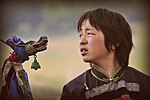The Nganasans (/əŋˈɡænəsæn/ əng-GAN-ə-san; Nganasan: ӈәнә"са(нә") ŋənəhsa(nəh), ня(") ńæh) are a Uralic people of the Samoyedic branch native to the Taymyr...
28 KB (2,807 words) - 18:20, 6 September 2024
тавги, tavgi) is a moribund Samoyedic language spoken by the Nganasan people. Nganasan is the most divergent language of the Samoyedic branch of the...
27 KB (1,830 words) - 13:30, 9 September 2024
Nganasan may refer to: Nganasan people, an indigenous people of the Russian Far North Nganasan language N. Ganesan (1932–2015), chairman of the Football...
294 bytes (58 words) - 12:30, 21 June 2021
Shamanism in Siberia (section Nganasan)
of Nganasan people enabled that shamanism was a living phenomenon among them even in the beginning of the 20th century, the last notable Nganasan shaman's...
38 KB (3,732 words) - 21:38, 12 August 2024
Samoyedic languages and peoples have been divided into two major areal groups: Northern Samoyedic (Nenets, Yurats, Enets, Nganasans), and Southern Samoyedic...
6 KB (361 words) - 16:44, 30 July 2024
the Taimyr Peninsula by the Nganasan people. Before the expansion of universal education in the 20th century, most Nganasan spoke only their own language...
2 KB (143 words) - 14:29, 20 September 2024
tundra. In the Nganasan language, "taa mire" translates to "reindeer paths." The Nenets people, also known as Samoyeds, are an indigenous people in northern...
10 KB (856 words) - 01:49, 21 September 2024
Shamanism (redirect from Shamanism among the Indigenous peoples of the Americas)
location of Nganasan people allowed shamanism to be a living phenomenon among them even at the beginning of the 20th century, the last notable Nganasan shaman's...
83 KB (9,586 words) - 12:07, 19 September 2024
Hungarians (redirect from Magyar people)
culture people, the earliest Uralic-speakers can be associated with an Ancient Northern East Asian lineage maximized among modern Nganasans and a Bronze...
114 KB (11,258 words) - 14:38, 17 September 2024
Russians. This Eastern Siberian-like ancestry is maximized among modern Nganasan people and a Bronze Age specimen from Southern Siberia (Krasnoyarsk_Krai_BA)...
14 KB (1,427 words) - 20:22, 2 May 2024
Genetic studies on Sami (redirect from Population Genetics of the Sami Peoples)
originating from a Neo-Siberian source population, best represented by the Nganasan people. The specific Siberian-like ancestry is proposed to have arrived in...
26 KB (3,091 words) - 10:15, 30 April 2024
Siberia. U4 is found in the endangered Nganasan people of the Taymyr Peninsula, in the Mansi (16.3%), and in the Ket people (28.9%) of the Yenisei River. It...
86 KB (9,284 words) - 21:55, 24 September 2024
component, which most closely corresponds to the modern North Siberian Nganasan people of the lower Yenisey River, to varying degrees, but generally higher...
68 KB (7,012 words) - 21:11, 22 September 2024
Seima-Turbino culture (category Uralic peoples)
Neolithic/Bronze Age Eastern Siberians, which peaks among Uralic-speaking Nganasan people. They also displayed affinity to Okunevo culture remains, which in...
27 KB (2,874 words) - 13:58, 16 September 2024
pool appeared in the Bronze Age from the admixture of Mezhovskaya and Nganasan people, supporting genetic and linguistic data". Another study published in...
113 KB (14,063 words) - 14:32, 25 August 2024
Easter Island, recorded on this island. In the creation myth of the Nganasan people, at first, the Earth was completely covered with water, then the water...
28 KB (3,621 words) - 22:23, 26 August 2024
enter their land. Samoyedic peoples include: Northern Samoyedic peoples Nenets Enets Nganasan Southern Samoyedic peoples Selkup Kamasins or Kamas Mator...
47 KB (4,361 words) - 19:14, 9 September 2024
Russia Samoyedic Nenets, Russia Enets, Siberia (Krasnoyarsk Krai), Russia Nganasan, Siberia (Krasnoyarsk Krai), Russia Selkup, Siberia, Russia Yukaghirs,...
13 KB (1,398 words) - 22:04, 26 August 2024
of ancestry from a "Siberian" source maximized in modern day Nganasan people. Nganasans and a historical specimen from Bronze Age Southern Siberia (Krasnoyarsk_Krai_BA;...
33 KB (4,343 words) - 13:55, 11 August 2024
Scytho-Siberian world (section Peoples)
component most closely corresponding to the modern North Siberian Nganasan people of the lower Yenesei. Furthermore, archaeological evidence now tends...
63 KB (7,323 words) - 23:53, 6 July 2024
Ordos culture (redirect from Ordos people)
component, which most closely corresponds to the modern North Siberian Nganasan people of the lower Yenisey River, to varying degrees, but generally higher...
38 KB (4,387 words) - 08:58, 5 September 2024
among other peoples who speak Uralic languages. Some of them maintained shamanism until modern times; the isolated location of Nganasan people made it possible...
16 KB (1,753 words) - 16:57, 7 June 2022
Samoyedic languages and peoples have been divided into two major areal groups: Northern Samoyedic (Nenets, Yurats, Enets, Nganasans), and Southern Samoyedic...
13 KB (1,344 words) - 03:09, 10 September 2024
the admixture of local Srubnaya-like ancestry (c. 74%) with additional Nganasan-like (c. 18%) and Ancient North Eurasian (c. 8%) admixture. The later proto-Ugric...
8 KB (911 words) - 06:56, 21 September 2024
Nenets (redirect from Samoyed (people))
applied indiscriminately to different peoples of Northern Russia who speak related Uralic languages: Nenets, Nganasans, Enets, Selkups (speakers of Samoyedic...
32 KB (3,762 words) - 20:33, 5 September 2024
about 60% Bronze Age Baikal Lake-like and 40% Srubnaya-like, or about 54% Nganasan-like and about 38% Srubnaya-like, with additional ANE-related admixture...
19 KB (2,041 words) - 18:29, 18 August 2024
grounds, the prehistory of Siberia, Inner Asia, prehistoric Japan, the Nganasan people, Eskimos, and the Chukchi Peninsula. Chard, Chester (1962). Arctic...
4 KB (396 words) - 12:23, 13 April 2024
estimated to be Nganasan-like. This Siberian-related component is typical for Uralic populations. Sami people Nenets people Indigenous peoples "Russian Census...
31 KB (3,275 words) - 02:27, 20 September 2024
hominine Dolgans Kazakhs (before USSR) Kyrgyz (before USSR) Ket Meenas Nganasan Nicobarese Papuans Penan Raute Sakai Selkup Semang Siberian Yupik Yakuts...
22 KB (1,840 words) - 06:23, 7 September 2024
Uralic languages (redirect from Uralic people)
present only in Nganasan. Vowel harmony is present in the Uralic languages of Siberia only in some marginal archaic varieties: Nganasan, Southern Mansi...
88 KB (7,555 words) - 07:24, 24 September 2024























